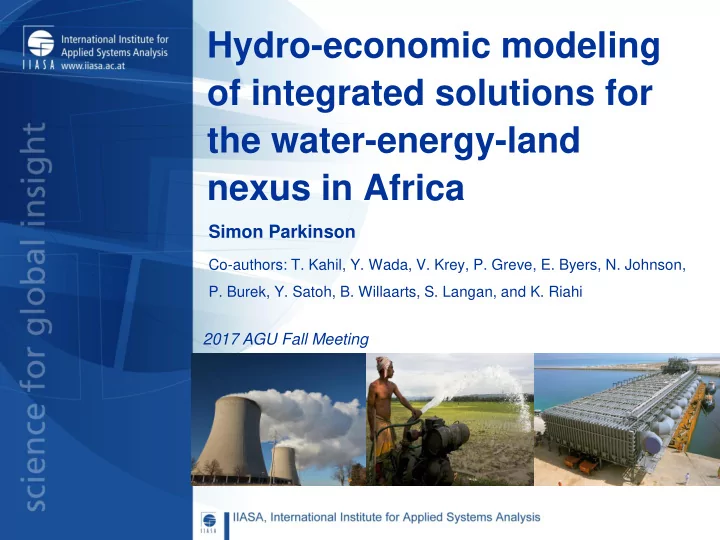

Hydro-economic modeling of integrated solutions for the water-energy-land nexus in Africa Simon Parkinson Co-authors: T. Kahil, Y. Wada, V. Krey, P. Greve, E. Byers, N. Johnson, P. Burek, Y. Satoh, B. Willaarts, S. Langan, and K. Riahi 2017 AGU Fall Meeting
Infrastructure gaps in Africa What technologies to use? How much will it cost? Access to wastewater treatment in 2010 Access to electricity in 2010 Target 6.3 Target 7.1 ` Half of all wastewater Universal access treated by 2030 by 2030 Baum et al. (2013) World Bank Indicators (2016)
Climate change and Africa’s water -energy-land nexus ` Sikombe, 2017 In 2016 (from Zambia Energy Regulation Board, 2016) • Blackouts averaging eight (8) hours a day • Power imports increased to 2,184 GWh, from 785 GWh, in 2015 (180% increase)
Integration of regional electricity markets couples basin adaptation planning across the African continent Conway et al. (2017) Linking of regional electricity sharing mechanisms could mitigate intraregional risk ` Wu et al. (2017) Regional interconnections are crucial for realizing no- regrets wind and solar energy development Research Challenge How to balance regional opportunities with localized resource constraints?
Hydro-economic modeling “Hydro -economic models represent spatially distributed water resource systems, infrastructure, management options and economic values in an integrated manner,” Harou et al. (2009). • Most hydro-economic models focus on existing infrastructure – Limited ability to look at long-term transformations. • Most hyrdro-economic models focus on a single basin Research Objectives • Develop a new integrated hydro-economic modeling tool for water and electricity sector expansion planning in Africa – Spatially-distributed water and energy resources – Long-term planning horizons (pathways to 2050) – Flexible implementation for application in other regions
ECHO E xtended C ontinental - scale H ydro-economic O ptimization ` Kahil et al. (forthcoming)
Projecting water infrastructure demand under clean water goals Baum et al. (2013) % connected / treated is a function of Country-level database % of population with income-level and historical level sewerage connection and treatment ` F(.…)
Preliminary scenario analysis: Focus on water infrastructure pathways to 2050 Three socio-economic and Average Annual Growth - Urban Water Withdrawals climatic scenarios: 1/ Middle of the Road ( MoR ): SSP2-RCP6.0 2/ Regional Rivalry ( RR ) : Water demand increases over time in all water sectors and water availability decreases, compared to MoR. 3/ Sustainability (Sust) : Water demand decreases over time in all water sectors and water availability increases, Parkinson et al. (2016) compared to MoR .
Results Balancing water supply and demand Africa – Water Supply & Demand ` Non-conventional
Results Investment requirements By Country By Basin Africa – Total Investment 2050 2050 ZAF NILE EGY NIGER SDN AWS NGA MSCS ZMB ZAMB ETH VOLT GHA SASC UGA ORNG MLI CNGO DZA LMPO ` ZAF NILE EGY NIGER SDN AWS NGA MSCS ZMB ZAMB ETH VOLT GHA SASC UGA ORNG MLI CNGO DZA LMPO ZAF NILE EGY NIGER SDN AWS NGA MSCS ZMB ZAMB ETH VOLT GHA SASC UGA ORNG MLI CNGO DZA LMPO billion USD/year
Results Increasingly electricity-intensive water sources Africa – Electricity Demand from Water Supply Effects of CO2 mitigation 240 RR Surface Water 50% less CO2 230 Groundwater Non-conventional Total Investment Costs 220 Irrigation systems ` 210 RR Baseline 200 190 180 170 RR RR+50% reduction i
Ongoing and future work • Electricity sector calibration • Planned projects • Adaptive land use • Integrated policy analysis • Application to other regions
Conclusions • Water and energy access closely interlinked in Africa over multiple geographic scales – Hydro-economic models need to be extended to incorporate energy and land-use transitions • Water infrastructure costs vary considerably – Efficiency and behavioral changes can provide significant savings, especially in water-stressed regions • Climate change mitigation could drive up costs to supply freshwater – Subsidies might be needed in some regions to protect low-income and vulnerable populations Thank you! Funding and support provided by:
Extra
Features of the ECHO modeling framework Demand growth; Resource availability; Climate change; Drivers Administrative boundaries; Basin delineations; etc. Reservoir management; Irrigation; Electricity generation; Water Processes pumping; End-use efficiency; Wastewater treatment; etc. ` Prices; Demands; Emissions; Water quality; Environmental flow; Impacts Groundwater depletion; Resource security; etc. Extract resources; Operate infrastructure; Expand infrastructure; Decisions Trade resources; Fulfill SDG objectives; etc. ECHO provides an integrated platform for exploring feasible adaptation options under human development and environmental constraints
Spatial delineation: Tracking transboundary flows ` Data sources: HydroBASINS (Lehner and Grill,2013); GADM, 2015
Existing water infrastructure capacity Data sources: Wada et al. 2011; AQUASTAT; Fan (2013); Desaldata (2015)
Presumptive standards for environmental flow protection as constraints on surface and groundwater withdrawals Rivers Aquifers ` Gleeson and Richter, (2017)
Hydropower potential at the basin-county level Multi-model mean from van Vliet et al. 2016 RCP 2.6
Future municipal water demands y Country-level Scenario narratives y a b ln x Material-intensive Sustainable Reduced by long-term technological change x Figure: Per capita GDP vs. per capita freshwater withdrawal. 20 [ Data from: FAO AQUASTAT ; World Bank Indicators ]
Country-level results Figure: Demand curves obtained for eight countries (including technological change). S Parkinson, et al. Environmental Modelling & Software (2016)
Innovations Water, energy and food demand modeling at the basin-scale Electricity demand by country [ MW ] Spatially-explicit electricity demand [ MW ] Rural Urban Preliminary results
Existing infrastructure 23
Recommend
More recommend